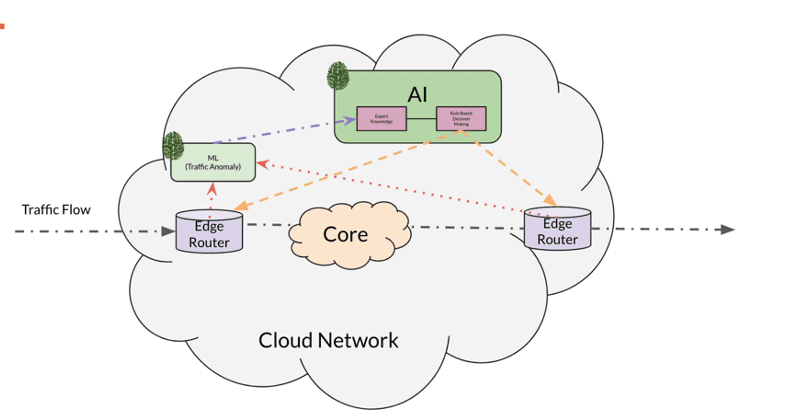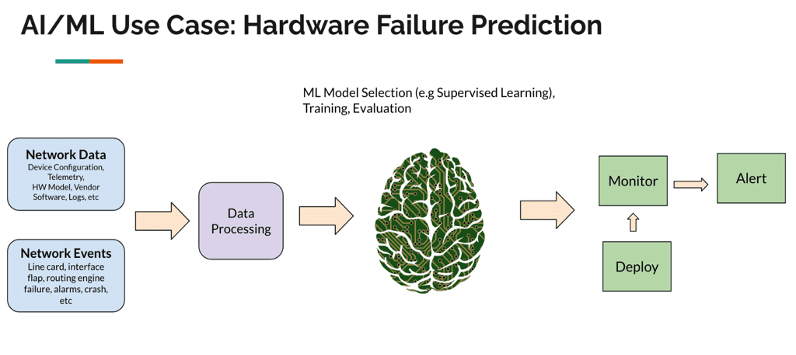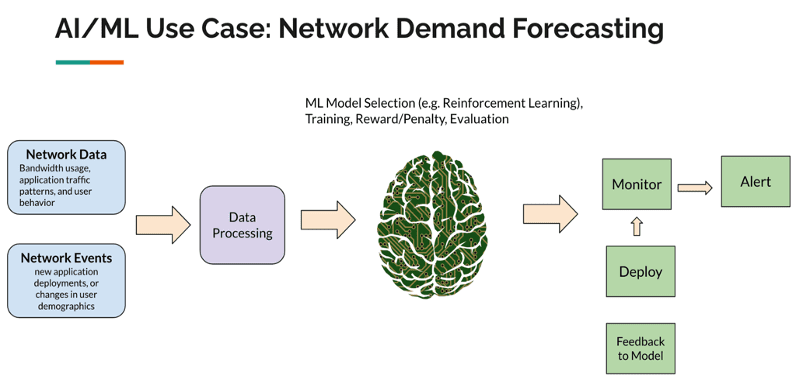Part-2: Unleashing Network Potentials: Current State and Future Possibilities with AI/ML
By Vinay Tripathi with Ajay Lotan Thakur
Introduction
In the dynamic realm of networking, AI/ML has emerged as a transformative force to reshape the networking world by making it more secure, reliable, efficient and optimized. In this blog we will dive into characteristics, possibilities, use cases and challenges of AI/ML in the networking.
About AI and ML
Definitions of AL/ML
AI and ML are often used interchangeably, but there are some key differences between the two.
- AI is the ability of machines to perform tasks that would normally require human intelligence, such as understanding natural language, recognizing objects, and making decisions.
- ML is a subfield of AI that allows machines to learn from data and improve their performance over time.
- DL = Uses neural networks for complex structured models and greater insights.
Types of AI/ML
AI/ML encompass a wide range of techniques and algorithms that can be used to solve a variety of problems. In the context of networks, AI/ML technologies can be broadly categorized into the following types:
Key Points:
- AI/ML taxonomy is continuously evolving due to industry growth and various methodologies and algorithms.
- The choice of AI/ML algorithm significantly influences business outcomes, including training time, prediction accuracy, and resource usage.
- The selection of algorithms depends on the type and volume of available data for a specific use case.
Popular ML Types:
- Supervised/Unsupervised: When available data is simple or significant pre-processing has resulted in high data quality:
- Neural Networks and Deep Learning: When you have substantial amounts of unstructured/structured data or unclear features these may offer superior accuracy over Classical ML methods
- AutoML: When you need to streamline machine learning model development, especially with limited expertise, time, or resources.
- NLP: When tasks involve text or language data and require automation, understanding, or generation of natural language content.
- Reinforcement learning: Suitable when you need to train agents to make sequential decisions in dynamic environments, optimizing for long-term rewards, and when there is a need for autonomous decision-making, such as in robotics, game playing, or autonomous systems.
Figure-1: Hierarchy of AI, ML and DL
Applications of AI/ML
AI and ML technologies provide a diverse array of applications in networks, encompassing security, engineering, capacity planning, and operations. These technologies have the capability to augment network security, optimize network design and performance, forecast traffic demand, and automate network tasks. This leads to enhanced efficiency, reliability, and overall network performance. Here are some specific examples:
Network Security
- Intrusion Detection System (IDS): AI-powered IDS can detect and respond to cyberattacks in real-time, providing a more robust defense against threats.
- Thread Detection and Prevention (TDP): AI can analyze network traffic to identify and prevent threats before they can cause damage.
- Anomaly Detection: AI can detect deviations from normal network behavior, indicating potential security incidents.
Network Engineering
- Quality of Service (QoS): AI can optimize network resources to ensure consistent and reliable performance for critical applications.
- Routing and Traffic Management: AI can optimize routing decisions and manage traffic flow to avoid congestion and improve network performance.
- Optimized Traffic Flow: AI can analyze traffic patterns and make real-time adjustments to optimize traffic flow, reducing latency and improving overall network performance.
- Load Balancing: AI can distribute traffic across multiple servers or network links to balance the load and prevent bottlenecks.
Network Capacity Planning
- Improved Capacity Forecasting: AI can analyze historical data and predict future traffic demand, enabling network operators to plan for future capacity needs.
- Efficient Uses of Resources: AI can identify and allocate network resources more efficiently, reducing costs and improving network performance.
Network Maintenance, Troubleshooting, Operations and Monitoring
- Real-time Monitoring: AI can continuously monitor network performance and identify potential issues before they cause outages or disruptions.
- Quicker Resolutions of Vendor/Hardware Issues: AI can diagnose and resolve vendor and hardware issues more quickly, minimizing downtime.
- Faster Root Cause Analysis: AI can analyze large amounts of data to identify the root cause of network issues, enabling faster resolution.
- Quick Mitigations of Network Issues: AI can automatically implement mitigations for network issues, reducing the impact on users and applications.
AI/ML Based Network in Action
The seamless integration of AI/ML components at various levels of the network (edge, core, management, etc.) enhances its reliability, efficiency, and security by optimizing performance and safeguarding against vulnerabilities.
The diagram illustrates a practical application of AI/ML within one of the extensive networks.
Figure-2: AI/ML in action in a cloud network
Trends in AI/ML
AI/ML are revolutionizing the field of networks. These technologies are being used to improve the performance, security, and reliability of networks.
Here are some of the key trends in AI/ML for networks:
- Simplify and scale data operations.
AI/ML can be used to automate and simplify many of the tasks involved in managing and analyzing network data. This can free up network administrators to focus on more strategic tasks.
- Increase accuracy of forecasts.
AI/ML can be used to predict network traffic patterns, identify potential problems, and plan for future capacity needs. This can help organizations to avoid costly downtime and improve the quality of service for their users.
- Decrease time to market.
AI/ML can be used to automate the process of designing, deploying, and managing new network services. This can help organizations to bring new products and services to market faster.
- Enable insights on otherwise unusable data
AI/ML can be used to extract insights from network data that would otherwise be too complex or voluminous to analyze manually. This can help organizations to identify security threats, optimize network performance, and improve customer experience.
Figure-3: Trends in ML
AI/ML Use Cases
The introduction of AI/ML use cases in network functions has revolutionized the field of networking. AI/ML technologies are being leveraged to enhance network security, optimize network design and performance, anticipate traffic demand, and automate network tasks. This integration leads to improved efficiency, reliability, and overall network performance.
Examples of the popular use cases of AI/ML in large networks.
Figure-4: AI/ML Use Case: Hardware Failure Prediction
Figure-5: AI/ML Use Case: Network Demand Forecasting
ML vs Non-ML Networks
The comparison of ML-based and non-ML-based networks provides valuable insights into the advantages and limitations of each approach. By examining the key aspects such as scalability, flexibility, accuracy, and security, organizations can make informed decisions about the most suitable solution for their specific networking needs. This comparison can guide network engineers, architects, and decision-makers in selecting the optimal approach to meet their performance, efficiency, and security requirements.
A comparison between ML-based and non-ML-based solutions is provided in the followingtable:
Figure-6: Comparison of ML and non-ML solutions
Reasons Not to Use AI/ML
While AI/ML technologies offer significant benefits for networks, there are certain scenarios where their application may not be suitable or feasible. Several factors, such as data availability, use case definition, cost considerations, the need for customized models, and the effectiveness of existing automation, can influence the decision to refrain from using AI/ML in networks. Understanding the limitations and potential drawbacks of AI/ML is crucial for organizations to make informed choices about the most appropriate approach for their specific networking needs.
- Not enough data sets to train the model:
- AI/ML models require large amounts of high-quality data to train effectively. In the context of networks, it may be challenging to collect and prepare sufficient data. Factors such as network size, traffic patterns, and security considerations can make data collection a complex and time-consuming process.
- The lack of adequate data can lead to models that are not well-generalized and may not perform well in real-world scenarios.
- Use case is not defined well:
- AI/ML models are designed to solve specific problems or achieve specific goals. If the use case for AI/ML in networks is not clearly defined, it can be difficult to develop a model that effectively addresses the desired outcomes.
- A poorly defined use case can lead to misalignment between the model’s capabilities and the actual requirements of the network.
- High cost is a problem:
- Implementing AI/ML solutions in networks can be expensive. Factors such as hardware requirements, software licenses, and the cost of hiring skilled professionals contribute to the overall cost.
- Organizations need to carefully evaluate the cost-benefit analysis before investing in AI/ML for their networks. In some cases, the cost of deploying and maintaining an AI/ML solution may outweigh the potential benefits.
- Customized AI/ML model is required:
- Off-the-shelf AI/ML solutions may not always be suitable for specific network scenarios. Organizations may require customized models that are tailored to their unique requirements.
- Developing customized AI/ML models requires specialized expertise and resources, which can further increase the cost and complexity of the project.
- Existing automation is already serving the requirement:
- Many networks already have existing automation solutions in place, such as network management systems (NMS) and configuration management tools. These solutions provide a range of automation capabilities that may already be sufficient for the organization’s needs.
- Implementing AI/ML in such scenarios may not offer significant additional benefits or may require a substantial investment to achieve incremental improvements.
AI/ML Challenges in Networks
AI/ML in networks has benefits but also challenges. Complexity arises from numerous interconnected components and interactions, which AI/ML further complicates. Data limitations and algorithmic bias are additional concerns. Regulatory compliance adds another layer of complexity. Some of the challenges are described in detail below:
Complexity
- As networks become increasingly complex, it can be difficult to troubleshoot issues that arise. This is due to the large number of interconnected components and the complex interactions between them.
- For example, a problem with a single router can have a cascading effect on the entire network, making it difficult to identify the root cause of the issue.
- Additionally, the use of AI and ML in networks can further increase complexity by introducing new layers of abstraction and decision-making.
Data Requirements
- AI and ML algorithms require large amounts of data to train and operate effectively. This can be a challenge for networks, as they may not have access to sufficient data to train their models.
- For example, a network security system may not have enough data on recent attacks to train a model to detect and prevent future attacks.
- Additionally, the data that is available may be biased or incomplete, which can lead to inaccurate or unfair models.
Algorithmic Bias
- AI and ML algorithms can be biased, which can lead to unfair or discriminatory outcomes. This is because the algorithms are trained on data that may contain biases, such as racial or gender bias.
- For example, a facial recognition system may be biased towards certain ethnicities, leading to false identifications or denials of service.
- It is important to address algorithmic bias in networks to ensure that AI and ML are used in a fair and responsible manner.
Regulatory Compliances
- Networks are subject to a variety of regulatory compliance requirements, such as the General Data Protection Regulation (GDPR) and the Health Insurance Portability and Accountability Act (HIPAA).
- These regulations impose strict requirements on how data is collected, stored, and used.
- AI and ML can add additional complexity to compliance, as they can introduce new data processing and decision-making processes.
- Organizations need to carefully consider the regulatory implications of using AI and ML in networks to ensure that they are compliant with all applicable regulations.
Ethical Concerns
- The use of AI and ML in networks raises several ethical concerns, such as the misuse of data and job replacement.
- For example, AI-powered surveillance systems could be used to track and monitor people without their consent, raising concerns about privacy and civil liberties.
- Additionally, AI and ML could lead to job automation, which could displace workers and have a negative impact on the economy.
- It is important to consider the ethical implications of using AI and ML in networks to ensure that they are used in a responsible and ethical manner.
Networks: AI/ML Benefits
In today’s digital world, networks are becoming increasingly complex and interconnected. To manage and operate these networks effectively, organizations are turning to AI/ML. AI/ML can automate repetitive tasks, identify, and mitigate network threats, and optimize network performance. AI/ML can also help organizations to gain more insights from their network data, which can lead to better decision-making and improved business outcomes. Some of the top benefits are described below:
Lower Cost:
- Automated tasks: AI/ML can automate repetitive and time-consuming network tasks, such as configuration, monitoring, and troubleshooting. This can free up staff to focus on more strategic initiatives.
- Efficient customer support: AI/ML-powered chatbots and virtual assistants can provide 24/7 customer support, answering common questions and resolving simple issues. This can reduce the need for human customer support representatives, saving costs.
- Improved performance: AI/ML can be used to optimize network performance by identifying and resolving bottlenecks and inefficiencies. This can lead to reduced latency, improved throughput, and better overall network performance while minimizing the network operation cost.
Reduced Network Risk:
- Resilient network: AI/ML can be used to create more resilient networks that are better able to withstand outages and attacks. This can be done by predicting and preventing network failures, and by quickly identifying and resolving issues.
- Identify and mitigate threats: AI/ML can be used to detect and mitigate network threats, such as malware, DDoS attacks, and phishing attempts. This can help to protect sensitive data and systems from being compromised.
- Accurate network trends and forecast: AI/ML can be used to analyze network data to identify trends and forecast future needs. This information can be used to make informed decisions about network planning and investment.
- Network outage prediction: AI/ML can be used to predict network outages before they occur. This can help to prevent downtime and lost productivity.
More Revenue:
- Enhanced network and capacity planning: AI/ML can be used to optimize network and capacity planning, ensuring that the network has the resources it needs to meet current and future demands. This can help to avoid costly over-provisioning or under-provisioning of network resources.
- Faster time to market: AI/ML can help to accelerate time to market for new network services and applications. This can be done by automating the testing and deployment process, and by identifying and resolving potential issues early on.
- Better customer experience: AI/ML can be used to improve the customer experience by providing personalized and proactive support. This can lead to increased customer satisfaction and loyalty.
Networks: AI/ML Innovation Catalysts
The convergence of AI/ML with networks is revolutionizing various industries. Here are some key factors driving this transformation:
- Increase in Data/Compute and Storage:
- The proliferation of IoT devices has led to an exponential growth in data generation, fueling AI/ML innovation.
- High-performance computing (HPC) clusters and cloud platforms provide the necessary compute and storage resources for complex AI/ML models.
- Edge Computing:
- Edge computing brings AI/ML capabilities closer to data sources, enabling real-time decision-making.
- Edge devices, such as sensors and gateways, collect and process data locally, reducing latency and bandwidth requirements.
- Cloud Infrastructure:
- Cloud platforms offer scalable and elastic infrastructure for deploying and managing AI/ML workloads.
- Cloud-based AI/ML services provide pre-built tools and frameworks for developers, accelerating the development and deployment of AI/ML applications.
- Increase in Devices Running AI:
- Smartphones, smart home devices, and autonomous vehicles are increasingly equipped with AI capabilities.
- These devices generate vast amounts of data and use AI to perform tasks such as image recognition, natural language processing, and predictive analytics.
- Pre-trained Models:
- Pre-trained models, such as open-source BERT and ResNet, provide a starting point for developing custom AI models.
- These models have been trained on large datasets and can be fine-tuned for specific tasks, reducing the time and resources required for model development.
- Human and AI Cooperation:
- AI/ML is augmenting human capabilities, enabling collaboration between humans and machines.
- Human-AI teams can leverage their respective strengths to solve complex problems and make better decisions.
Conclusion
AI and ML are revolutionizing the field of networking, bringing efficiency, automation, and significant performance improvements. As networks continue to grow and complexity, traditional management methods are becoming increasingly ineffective. AI and ML offer a powerful solution by enabling networks to self-configure, self-optimize, and self-heal, leading to a more agile, resilient, and cost-effective network infrastructure. The use of AI and ML in networks is still in its early stages, but it has the potential to transform the way networks are designed, built, and operated. As AI and ML technologies continue to evolve, we can expect to see even more innovative applications that will further unleash the potential of networks.
References
- https://cloud.google.com/blog/products/infrastructure/google-network-infrastructure-investments
- https://www.cisco.com/c/en/us/solutions/collateral/executive-perspectives/ai-ml-overview-of-industry-trends.html
**** This blog post was written with the assistance of Google’s Gemini. The AI was used to generate initial draft, rephrasing, and brainstorming, which I then refined, edited, and expanded upon.
One thought on “Part-2: Unleashing Network Potentials: Current State and Future Possibilities with AI/ML”
Comments are closed.









Thank you for the very interesting articles. I would look forward to more articles with specific examples of systems applying AI/ML to the networking world and possibly comparing with the state-of-the-art “automation” solution.
I have sometimes thought about a fine-tuned Large Language Model (LLM) applied to interpreting logs from multiple network devices. A human reading multiple logs can be time-consuming, tedious and require a lot of expertise. An LLM summarizing the logs from a network (and possible isolating “noise” from “significant” events) may accelerate the diagnosis of a complex issue.